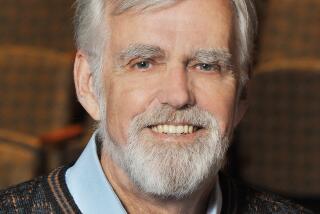Latest Work Is Bowen’s Most High-Profile : Composer and performer of new music spent years working on the fringes.
- Share via
Listening to the lilting strains of Gene Bowen’s new album “The Vermilion Sea” as you drive along the Rincon, some kind of sonic/geographical synchronicity takes place.
The Vermilion Sea was the name given by the Spanish explorers to the Gulf of California, and this terrain, full of dry brush and the gently lapping expanse of the Pacific Ocean, is much the same scene you’ll find hundreds of miles south.
It’s a terrain that honors no border. Likewise, the musical map.
The trail to Bowen himself leads to an apartment half a block from the beach in Ventura. Here, the Nordic-looking Bowen has a few guitars, a synthesizer and the all-important computer--his main composing tool--and piles of records and CDs. A surfboard--for his 13-year-old son--sits on the front porch. The bare necessities.
Bowen’s project was recently released on Gyroscope, the new label with a roster that includes Brian Eno, Harold Budd and others at the soothing end of the new music spectrum. This is a tender time for Bowen, who has spent years working on the fringes of new music as a composer and performer, and whose current project is his most high-profile.
But it didn’t happen overnight. Three years ago, Bowen began his work-in-progress, creating the raw material on synthesizers and computers. He gradually replaced the canned segments with his own guitar parts and tracks by guest musicians, including such key new music players as percussionist John Bergamo, bassist Buell Neidlinger, and Budd.
“On a couple of pieces,” Bowen said, “I actually stripped away the initial composition and just left the player, like on the North Indian flute piece (‘As I Lay Dying’). I ended up completely stripping the synthesizer away and leaving that flute solo until the end.”
In a way, the real instrumental heart of the album is Mexico City-based harpist/vocalist Cynthia Valenzuela. Her clean, delicate harp parts are laced throughout most of the album, whether on the themes of Mexican folk songs or on original material.
“I’ve traveled in Mexico extensively,” Bowen explained, over a lunch of a tostada and beer, “and I’ve always had the notion of writing pieces to Mexican folk songs, ever since I heard Copland’s ‘El Salon de Mexico,’ which is ripped off by every western movie.
“Part of my concept for the album was to incorporate American folk melodies along with African and Mexican folk songs.”
Though born in Mississippi, Bowen discovered America as an Army brat whose family moved regularly. The family finally landed in Oxnard when Bowen was in high school, partly because Bowen persuaded his father to move to the land of the Beach Boys.
“I’ve basically been in Ventura County since then,” he said.
After studying music at Moorpark College, Bowen found his curiosity piqued and his aesthetics forged at the then-newly opened Cal Arts. There, a happy convergence of studies in ethnic music, electronic music and other disciplines left its mark on him.
“My interests came through guitar music and songwriting coupled with interest in folk and ethnic music, where repetition is always so important. Repetition and texture are almost more important than western harmony. For me, it’s always been a natural thing to be doing as little as possible,” he grins, half-serious.
In the ‘70s, Bowen wrote music, worked as a teacher, and played in the country-Western band The Chesterfield Kings (“named after our favorite cigarette”), which played at spots such as the old Glenoaks Hotel in Santa Paula. Next came the rock band the Sleeping Dogs, which recorded an album for a French label that went belly up just after the album’s release.
Bowen also did some music-copying work for renowned composer-conductor John Adams--as he did briefly for Frank Zappa--and was hired by Adams to perform in the “New and Unusual Music” series of the San Francisco Symphony.
Budd, in particular, has been a friend and mentor to Bowen since his Cal Arts days, when Budd was teaching there.
In the ‘80s, Bowen released an experimental record called “Bourgeois Magnetic” on the Cantil label, run by Budd and himself. Later, Bowen worked on Budd’s album “Abandoned Cities,” released on Opal/Warner Brothers.
Budd and Bowen also pieced together various music at the Old Rugged Cross, the name of Bowen’s home studio on a ranch in Fillmore where he lived and worked for 14 years. The pair hope to release music from those sessions titled “The Orange Grove Archives.”
For now, “The Vermilion Sea” is his focus, the long-awaited opus now gone public. “Due to that long process, I was able to live with those pieces and really hone them--which is why I can’t even stand to listen to it now,” he said. “It seems to hold up. People comment that they like the way it flows. It’s sort of like a novel. You want it to start, go through all its chapters and end.”
“One of the terrible things is: How do you categorize this kind of music? This is a battle everybody who doesn’t do pop music is up against. People ask me ‘is it New Age?’ I say ‘no, it’s more serious than that.’ ”
More to Read
The biggest entertainment stories
Get our big stories about Hollywood, film, television, music, arts, culture and more right in your inbox as soon as they publish.
You may occasionally receive promotional content from the Los Angeles Times.







